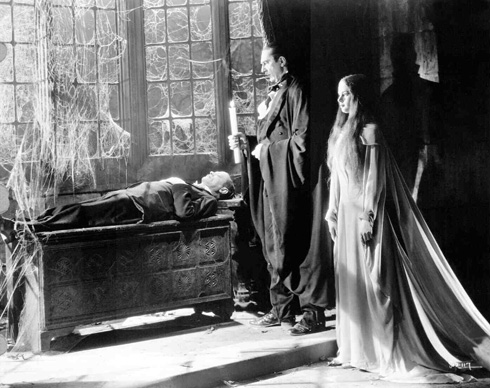
Filmmaker Tod Browning famously conceived of Mark Of The Vampire (1935) as a way to re-make or salvage his now lost silent feature London After Midnight (1927) starring Lon Chaney. Both Mark Of The Vampire and London After Midnight are based on Browning’s short story The Hypnotists though the latter film fails to credit this source material. The basic premise is that a police inspector enlists the help of a hypnotist to create a state of hysteria around some staged supernatural phenomenon in order to flush out a killer and solve a crime. In typical Browning fashion the story emphasizes macabre spectacle rather than narrative logic.
Mark Of The Vampire does slightly more than function as a particularly eerie whodunnit. The film is a sort of satire of Browning’s own film Dracula (1931). In Mark Of The Vampire Bela Lugosi and Carroll Borland play actors playing vampires in order to frighten the populace of some remote Czechoslovakian village. The function of Lugosi and Borland in Mark Of The Vampire mirrors their roles in the film and, with the closing scene, dispels much of the mystique of Lugosi’s performance in Dracula as well. The playful reflexivity of Mark Of The Vampire makes it the equivalent of James Whale’s The Bride Of Frankenstein (1935), at least in terms of its relationship to Browning’s Dracula.
Beyond the obvious self-parody in Mark Of The Vampire there’s a general sense of clowning in the film. Character actor Donald Meek gives his usual hyper-neurotic performance as Dr. J. Doskil who seems to jump at every bump in the night or every feline to emerge from within a suit of armor. The only lead in the film to rival the comedic hijinks of the supporting ensemble is Lionel Barrymore as the hypnotist Professor Zelen. In his usual fashion Barrymore hams it up as his Van Helsing-esque character fans the flames of vampire hysteria, espousing cliches with exuberant relish. Once Barrymore appears on the screen Mark Of The Vampire becomes his movie.
Although Mark Of The Vampire is a comedy it features a far more lavish and macabre production design than Dracula. The fog drenched exteriors and the spider-web laden interiors of the vampire’s castle rival Browning’s best work during the silent era. These spaces seem pulled from the nightmares of children who saw Dracula some four years earlier. The look and feel of Mark Of The Vampire is a total contrast to its plot, successfully balancing the comedic with the horrific and grotesque. Tod Browning was far more invested in his re-make of London After Midnight than he ever was in making Dracula and it shows in the quality of cinematographer James Wong Howe’s images.
One of the major differences between Mark Of The Vampire and Dracula that should not be neglected is that fact that MGM produced Mark Of The Vampire. While Universal Pictures dominated the market with horror films the other majors still churned out their fair share of spooky pictures. For MGM Mark Of The Vampire was a means to take a shot at Universal while for Browning it was a means to procure resources that he couldn’t get from other studios.
Today the rights for Mark Of The Vampire are owned by Warner Brothers, who recently restored the film and released it to Blu-Ray. This release doesn’t have the same abundant special features as Warner’s DVD release of Browning’s Freaks (also made at MGM) but it does boast an excellent transfer of a newly restored print. For any fan of horror films this Mark Of The Vampire release is a must own.
